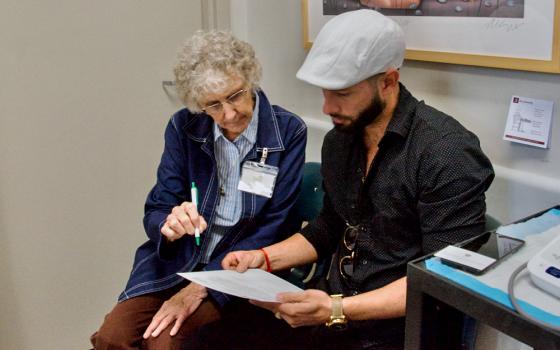
Ministries
KANSAS CITY, MO. -- Late summer and fall is a busy time for Lisa Ousley and Bernard Schneider. They have green beans, potatoes, tomatoes, melons, cucumbers and zucchinis to rescue. Tons of them.
Ousley and Schneider aren’t farmers. They’re gleaners. They take teams of volunteers into fields and orchards to pick fruit and vegetables that otherwise would be left to rot. Then they distribute the produce to food banks and agencies that serve the hungry.
Ousley and Schneider are the executive director and program coordinator respectively of the Society of St. Andrew’s Western Headquarters in Kansas City, Mo.
“Basically our goal is to get produce that is not marketable for cosmetic reasons and get it to people who cannot afford to buy produce,” Ousley said.
Commercial food producers have exacting standards for size, color and appearance. Zucchinis that grow too large, potatoes that didn’t grow big enough, blemished tomatoes or oddly shaped cucumbers can’t be sold.
Mechanized harvesting requires produce to be harvested within a certain time frame. If melons aren’t ripe when the machines are ready, they are left in the field. Mechanical pickers also miss hundreds of pounds of vegetables, and handpicking isn’t cost-effective.
Last year, the Society of St. Andrew mobilized 31,000 volunteers nationwide, rescuing 12 million pounds of fresh produce. By mid-August this year, its first full year of operation, the society’s Kansas City office had salvaged almost 4 million pounds.
According to federal figures, between 96 billion and 100 billion pounds of edible food is discarded in the United States every year. Only about 3 percent of it is salvaged. The rest is either plowed back into the fields or ends up in landfills.
“There is an obscene amount food wasted every year,” Ousley said. “It’s amazing how much fresh produce is thrown away just because it doesn’t look quite pretty. And the thing is, we all know it is perfectly good food.
A 2004 study of food loss in the American food system conducted for the USDA by Timothy Jones of the University of Arizona found that about half of the food produced in America was discarded.
Jones spent 10 years researching practices on farms and in orchards and examining retail outlets for fresh produce, food processing and production, and restaurants.
Jones found that 29 percent of citrus crops and 12 percent of apples grown in the United States never make it to market. Eighteen percent of harvestable vegetables don’t make it to market.
Cutting food waste would reduce serious environmental problems, according to Jones, by significantly reducing landfill use, soil depletion and applications of fertilizers, pesticides and herbicides.
In 1979, the Rev. Kenneth Horne and the Rev. Ray Buchanan were living in rural in Virginia working on hunger issues for the Methodist church.
“On the one hand they saw the abundance around them being wasted, and on the other hand they saw people in soup kitchens and shelters who were hungry. They thought this was wrong and started to do something about it,” Ousley said. That was the genesis of the society.
 “Their idea was to feed people with all this produce -- perfectly good, healthy nutritious produce -- that was being wasted,” she said. “They started talking to growers and produce packers about letting them have produce that they couldn’t sell. And they got volunteers from churches to help them” get the produce to food pantries.
“Their idea was to feed people with all this produce -- perfectly good, healthy nutritious produce -- that was being wasted,” she said. “They started talking to growers and produce packers about letting them have produce that they couldn’t sell. And they got volunteers from churches to help them” get the produce to food pantries.
Their first produce rescue operation was a truckload of sweet potatoes.
Today the society has offices in Alabama, Florida, Georgia, Mississippi, North Carolina and Virginia and has gleaning operations in 14 states distributing food in 32 states. The society opened an office in Kansas City to extend farther west.
The society also does numerous education programs about hunger and food production. The national office has Harvest of Hope retreats, which are weekend and weeklong programs that incorporate the study of hunger issues with work in fields and prayer and worship times. The retreats take place at various times of the year for various age groups.
One of the society’s most visible projects is the Potato Drop. A tractor truck trailer of potatoes -- between 42,000 and 45,000 pounds -- is dumped, generally in a church parking lot, and volunteers bag and distribute the potatoes to food banks, pantries and soup kitchens in the local area. Last year, the society salvaged 11.4 million pounds of potatoes. They also have “drops” of other produce.
The Potato Drops exemplify how the Society of St. Andrew likes to operate: cost effectively and cooperatively. The society pays for transportation and packaging. The food and labor are donated, and the food is distributed through existing organizations.
Though it has Methodist roots, the society’s outreach is ecumenical and interfaith. The Kansas City office works with Methodist, Church of Christ, Catholic and Jewish congregations.
Michael Halterman, chief executive officer of Catholic Charities of Kansas City-St. Joseph, Mo., said that his organization has endorsed the society’s work. Halterman has taken Ousley to deanery meetings throughout the diocese and worked with her to set up contacts -- especially with rural parishes -- to glean vegetables and fruit.
Asked what she thinks about as she gleans, Ousley said, “Well, I tell you, sometimes it’s hot!” She had just spent a long August weekend gleaning green beans. “Those green beans -- that’s tough work,” she said.
But whether picking green beans, peaches or zucchinis, “you know that you are feeding people. What you’re picking at that time is going to go onto someone’s dinner plate probably within two or three days. And it’s going to go to people who rarely see fresh fruits and vegetables.”
Schneider said, “Laboring to help some one else -- whether building a house with Habitat for Humanity or picking produce from a field -- the spiritual nourishment you get from that process is very important to the person doing it.”
He also notes that the farmers also benefit. “They don’t plant this in the first place to be plowed under. They are so grateful -- they want to see that it is feeding someone.”
Dennis Coday is an NCR staff writer. His e-mail address is dcoday@ncronline.org.
Related Web site
The Society of St. Andrew
www.endhunger.org


